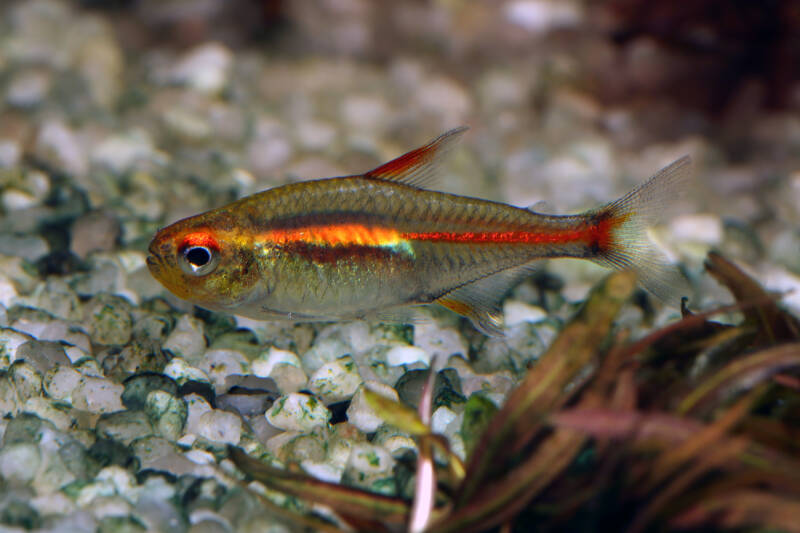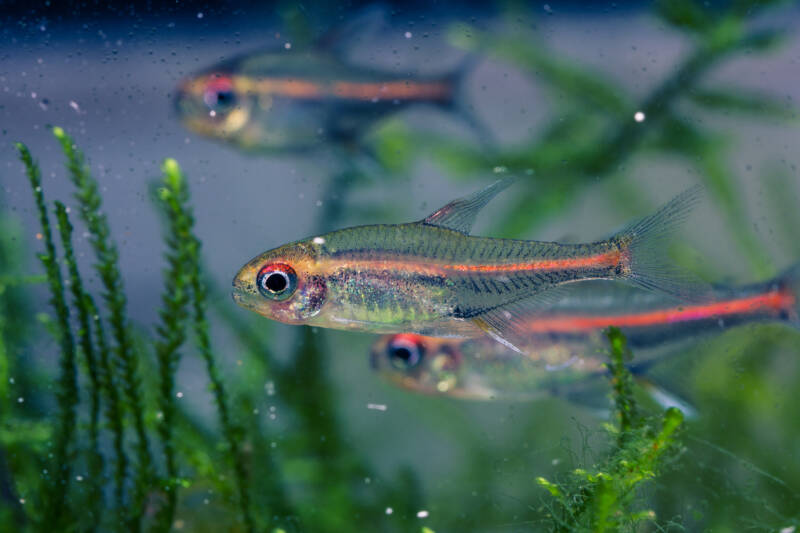With semi-transparent bodies and glowing red lines, glowlight tetras are beautiful freshwater fish that make a mesmerizing addition to any aquarium.
These peaceful schooling fish are hardy, active, and are excellent for a community tank.
Keep reading for more information on this fun tetra species.

At a Glance
| Tank Size: | 10 gallons minimum tank size |
| Group Size: | 5 or more |
| Water Temperature: | 72 to 80°F (22 to 27°C) |
| pH: | 5.5 to 7.0 |
| Hardness: | 2 to 15 dGH (4 to 8 ideal) |
| Lifespan: | 2 to 5 years |
| Breeding: | Egg layer |
| Adult Size: | 1.5 inches (4 cm) |
| Usual Place in the Tank: | Middle to lower levels |
[toc]
Natural Habitat
The glowlight (Hemigrammus erythrozonus) is a freshwater tetra from South America.
It inhabits both clear and blackwater rivers in Guyana, particularly the Essequibo River.
These warm rivers are full of plant debris, and the tannins released during decay tint the water, making it soft and slightly acidic.
Most of the fish available on the market today are tank-raised, but they still favor an environment matching their natural habitat.
Appearance and Biology

The unique appearance of the glowlight tetra, and the origin of its name, comes from its streamlined, semi-transparent body with a glowing orange or red midline.
The line extends the entire length of the head and body, crossing the eye and terminating at the base of the tail.
Coloration can become more prominent as the fish ages.
Sexing
It is difficult to differentiate males from females, although the female can be slightly larger, and males sometimes have a brighter midline stripe.
Usually, the first indicator that your fish is a female is when she develops eggs. At that point, she will appear rounded in the abdomen.
Size
Glowlights are small tetras. As an adult, they will stay less than two inches (5 cm) in length. However, most reach about 1.5 inches (4 cm).
Lifespan
With proper care, your glowlight can live anywhere from two to five years.
Behavior

Glowlight tetras are very active schooling fish that do best in groups of five or more. They are shy if kept as a single specimen and more confidently explore the tank in a group.
They swim predominantly in the middle to lower levels of the water column.
These community fish get along well with others; however, some natural behaviors sometimes concern the novice aquarist.
These fish are playful and tend to chase others. There is no harm in this behavior, but it can be interpreted as aggression.
Glowlights are seldom aggressive but can fin nip in response to environmental stressors or when establishing dominance. But, again, this behavior does not typically result in harm and usually resolves itself.
Another interesting behavior of this tetra species is “fin flicking.” This action is in response to a threat and is more of a signal to others or protection against predators than aggression.
How many per gallon?
While a 10-gallon tank is the minimum tank size for a small school of five or six fish, remember that the active glowlights love to swim and prefer a well-planted tank.
To ensure enough space, consider a 20-gallon tank for the optimum health of your fish.
Tank Setup

Setting up and maintaining a freshwater aquarium is simple for glowlight tetras. Select a tank that is longer than it is high.
Decorations
Line the tank bottom with a dark, sandy substrate to provide a dramatic backdrop for your tetra’s colors.
Choose aquarium plants with varying heights and arrange them to have a good-sized open space for swimming.
Floating plants can help to dim the light, which these tetras prefer. Add in some small to medium-sized rocks and driftwood to create a natural habitat.
Water Conditions
Although most fish on the market are tank-raised, you still need to maintain the water parameters as closely as possible to their natural habitat.
Keep the water temperature in the range of 72 to 80 degrees Fahrenheit (22 to 27 degrees C), with around 77° F (25° C) being a good target.
The water should be slightly acidic, with a pH level between 5.5 and 7.0.
Soft water from 4 to 8 dGH is best, but glowlights can tolerate anything in the range of 2 to 15 dGH.
Adding a few almond leaves or aquarium-safe peat moss to the filtration system will tint the water slightly and help with acidity and softness. Replace the leaves every few weeks.
To keep your water conditions at their best, change out 20% to 30% of the water every two weeks. Invest in a quality testing kit and test your water regularly.
Equipment
Because these fish like the water warm, use a heater and thermometer.
Keep the tank lighting dim to allow your glowlight tetras to show off their colors. A standard hang on back filter is sufficient to keep the water clean as these tetras are not particularly messy fish.
Tank Mates

Pair your glowlight tetras with similarly-sized, peaceful species for the best community tank mix.
Consider these species to pair with your glowlight tetra:
You can pair your glowlight tetras with freshwater shrimps, but the fish may prey on the offspring occasionally.
Avoid the following:
- Larger fish species that would consider the small tetra food, especially angelfish
- Fish with aggressive or semi-aggressive temperaments.
Many ask if tetras can be kept with the more aggressive betta fish. This is possible with a large enough tank (think 20 gallons), a school of at least six tetras, and plenty of hiding spaces.
Add the tetras first for the best chance of success.
Food and Diet
Glowlight tetras are easy-to-feed omnivores. They take a variety of commercial, freeze-dried, frozen, or live foods.
The base of their diet should be a high-quality micro pellet or flake food.
Round out their nutritional needs with live or frozen, small-sized foods, including brine shrimp, daphnia, or bloodworms.
Feed them small amounts two or three times daily. Only give what they can finish in a few minutes.
Breeding
These tetras are an egg-laying species that will readily breed in an aquarium setting with the right tank conditions.
Setting up a Breeding Tank
Set up a small, separate breeding tank with the same water conditions as the community tank.
Make sure the water is very soft and acidic. Install a sponge or peat filter and aim for a water hardness of 4.0 dGH.
Add a few plants, such as hornwort or water wisteria. Lower the lighting to nothing or almost nothing and gradually increase it until spawning occurs.
Spawning
Condition the breeding pair with high-nutrient foods, such as mosquito larvae. Feed them three times daily, but do not overfeed.
When you notice that the female has become rounded with eggs, transfer your pair to the breeding tank.
Within 24 hours, the pair should spawn, with the female depositing up to 150 eggs and the male fertilizing them. Remove the parents when this is complete as they may eat the eggs.
Caring for the Fry
The eggs will hatch within 24 to 36 hours. The newly hatched fry will be very tiny and resemble delicate slivers of glass.
They remain with their egg sacs at first and become free swimming in a couple of days.
Feed them infusoria to start, then switch to brine shrimp and microworms as they grow.
Within three weeks, the fry will reach a length of 0.4 inches (1 cm), and you will begin to see their bright red midline develop. Perform regular water changes as the fry develop and keep the lighting low.
Hardiness and Diseases
Glowlight tetras are hardy fish but remain sensitive to shifts in water parameters.
Before introducing them to your community tank, place them in a quarantine tank and gently acclimate them to your tank water using a drip system or by adding small amounts of water every 10 minutes.
Because almost all glowlight tetras on the market are captive bred, they are highly resistant to common freshwater tank ailments.
However, they can contract neon tetra disease, which is fatal. This parasitic infection presents as a pale white spot or cyst below the dorsal fin.
The infected fish will begin to lose color and have difficulty swimming. They may also develop a distinct curvature of the spine.
There is no cure for this disease. Remove any infected fish immediately to prevent the loss of your entire school.
Neon tetra disease can be contracted when fish feed on the deceased bodies of other fish and occasionally through eating live food, such as tubifex.
Regularly observe the behavior of your fish to detect a potential infection early. For example, if one fish is swimming erratically and distanced from the school, it may be infected.
Frequently Asked Questions
The following are frequently asked questions regarding glowlight tetras.
How many glowlight tetras can I put in a 10-gallon tank?
A maximum of six glowlight tetras can live in a 10-gallon tank.
However, in this setup, strict maintenance of water conditions is necessary to keep up the health of your fish.
A 20-gallon tank would allow more space for swimming and natural schooling behavior.
Are glowlight tetras fin nippers?
They are fin nippers, but not typically to the point where it is a problem. Instead, they nip to establish dominance, defend territory, or if they are stressed.
The problem usually resolves itself (unless it is due to environmental stressors).
If the nipping persists, then the aggressive fish may need to be removed.
Why are my glowlight tetras chasing each other?
Aggression with glowlight tetras is rare; however, there are some instances where they can fight.
Overstocking a small tank can be one cause. Another may be if you have a sick or injured fish.
A third reason may be that they are reacting to a shift in water conditions. Test your water and correct any off parameters.
Finally, glowlight tetras are simply playful fish and enjoy chasing for the sake of the chase. While this habit can be concerning to new aquarists, it is a normal behavior among tetra species.
Can neon tetras live with glowlight tetras?
Yes. Neon tetras are similarly small and peaceful fish. Also, they require similar water parameters as do the glowlight tetras, making them ideal tank mates.
Can glowlight tetras live with guppies?
Yes. Both species have similar water parameter needs, and both are excellent community fish in terms of temperament.
Make sure that the tank size is large enough to allow a suitable sized school for each species.
Closing Thoughts
Easy to care for, active and playful, and a great community fish, the glowlight tetra is suitable for beginner and experienced aquarists alike.
As a bonus, they cost less than $2 for an individual fish, less if purchased in groups, and can inhabit a range of tank sizes and water conditions.
They pair well with numerous other fish species and grace the tank with their beautiful schools.
What is your favorite community tank setup including glowlight tetras? Send us a message below!
